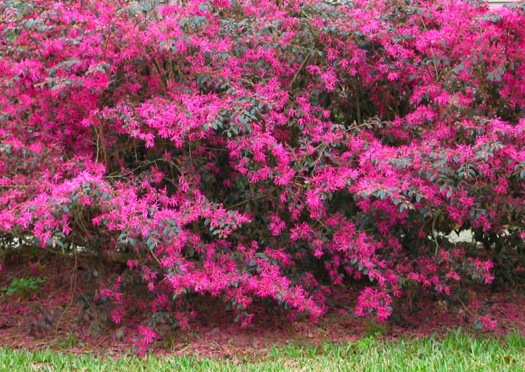Growing Loropetalums
 Sunday, March 20, 2016 at 8:00PM
Sunday, March 20, 2016 at 8:00PM This has been a marvelous year for loropetalums. Loropetalum chinense, or Chinese fringe flower, is in full bloom, and every neighborhood in my area seems to have at least a few lovely specimens. The pink flowered varieties with purple leaves, Loropetalum chinense var. rubrum, are especially eye catching. A member of the Witch Hazel family, Hamanelidaceae, all of these shrubs have clusters of delicately scented, fringe shaped flowers. The green leafed cultivars have white to ivory flowers, while the purple-leafed ones have showy pink blooms.
A member of the Witch Hazel family, Hamanelidaceae, all of these shrubs have clusters of delicately scented, fringe shaped flowers. The green leafed cultivars have white to ivory flowers, while the purple-leafed ones have showy pink blooms.
 Lorapetalum 'Carolina Moonlight' is a white flowering cultivar that grows to about 6 feet tall and wide.
Lorapetalum 'Carolina Moonlight' is a white flowering cultivar that grows to about 6 feet tall and wide.
 Loropetalum 'Purple Diamond' grows in my own garden. It will reach 2-5 feet tall with a spread of 3-5 feet.Loropetalums will bloom heavily in spring, then again sporadically from summer into fall. All are evergreen, keeping their leaves through the winter, though some purple leafed ones may become greener during the summer.
Loropetalum 'Purple Diamond' grows in my own garden. It will reach 2-5 feet tall with a spread of 3-5 feet.Loropetalums will bloom heavily in spring, then again sporadically from summer into fall. All are evergreen, keeping their leaves through the winter, though some purple leafed ones may become greener during the summer.
Loropetalums come in various sizes to fit your needs. Selections vary from dwarf and low, spreading cultivars suitable for groundcover to selections that will grow up to 15 feet tall and wide.  Loropetalums in Atlanta Botanical Gardens.In fact, there are some century old plants reported to have reached to 35 feet tall. The larger varieties may have their lower limbs removed to create lovely tree form specimens. Select larger shrubs for a tall hedge or as a backdrop for smaller plants.
Loropetalums in Atlanta Botanical Gardens.In fact, there are some century old plants reported to have reached to 35 feet tall. The larger varieties may have their lower limbs removed to create lovely tree form specimens. Select larger shrubs for a tall hedge or as a backdrop for smaller plants.
These are easy care shrubs that generally require little maintenance. They grow well in USDA hardiness zones 7- 9. They flourish in full sun and rich organic acid soil that is moist but well drained. Most are fast growing. Fertilize in early spring with fertilizer designed for acid loving plants or for evergreens. Choose appropriately sized cultivars for the location to minimize the need for pruning. If pruning is desired for shaping or to control size, prune after spring flowering has ended.


